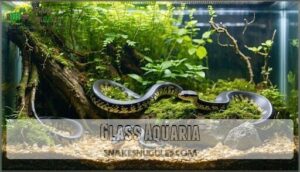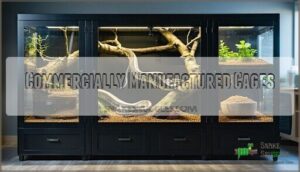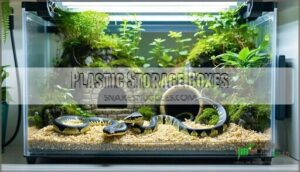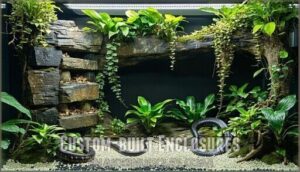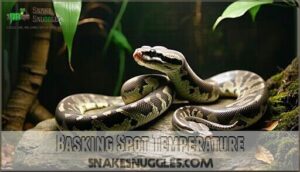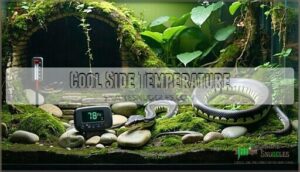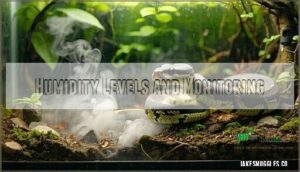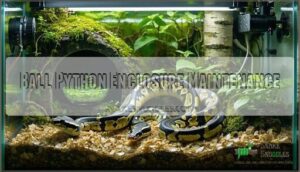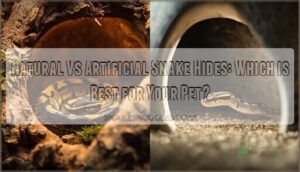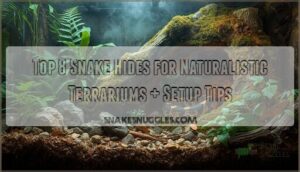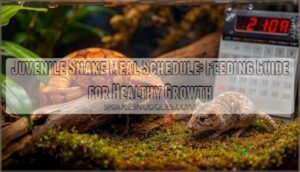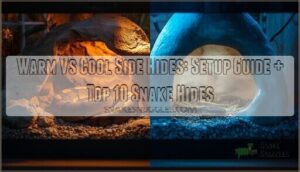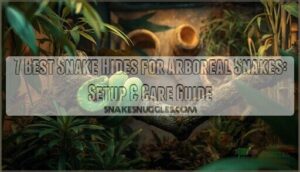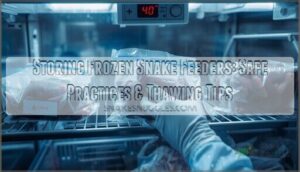This site is supported by our readers. We may earn a commission, at no cost to you, if you purchase through links.
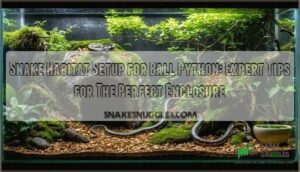
Maintain 50-60% humidity using a large water bowl and occasional misting. Include two hiding spots—one warm, one cool—plus sturdy branches for climbing.
Use aspen shavings, cypress mulch, or paper towels as substrate. Install under-tank heaters with thermostats for consistent warmth and ceramic heat emitters for nighttime heating.
A proper snake habitat setup for ball python creates security through tight spaces and consistent conditions. The substrate choice alone can make or break your snake’s comfort and health.
Table Of Contents
- Key Takeaways
- Ball Python Habitat Setup
- Choosing Right Enclosure
- Top 7 Ball Python Substrates
- Ball Python Temperature Control
- Ball Python Enclosure Maintenance
- Frequently Asked Questions (FAQs)
- What are the habitat requirements for a ball python?
- What is the best snake setup for a ball python?
- Can you leave a heat lamp on 24/7 for ball python?
- How often should ball pythons be fed?
- What lighting schedule do ball pythons need?
- Can ball pythons live with other snakes?
- How do I handle my ball python safely?
- What signs indicate my ball python is sick?
- Conclusion
Key Takeaways
- You’ll need a minimum 40-gallon tank (4’x2’x2′) for adults with secure ventilation and two hiding spots—one on the warm side and one on the cool side
- Create a temperature gradient with your basking side at 88-92°F and cool side at 76-80°F using under-tank heaters with thermostats to prevent dangerous overheating
- Maintain 50-60% humidity levels using a large water bowl and occasional misting, boosting to 70% during shedding cycles for healthy skin removal
- Choose safe substrates like aspen shavings, cypress mulch, or paper towels that support natural burrowing behavior while avoiding materials that cause impaction or mold growth
Ball Python Habitat Setup
When you set up a habitat for your ball python, you need to match their natural environment by controlling space, temperature, and humidity with precision.
This helps your snake feel secure, supports healthy behaviors, and prevents stress-related problems.
Native Habitat and Distribution
Ball pythons call the West African coast home, thriving across grasslands, scrublands, savannas, and open forests from Senegal to Uganda.
From Senegal’s grasslands to Uganda’s forests, ball pythons thrive in the heart of West Africa.
You’ll find them adapting to disturbed area habitats near farms, seeking rodent burrow shelter for ideal environmental conditions.
These natural habitat regions provide the perfect blueprint for recreating their environment in captivity, with many being sourced through exports from Togo, offering a unique insight into their natural habitat.
Enclosure Size and Requirements
Your adult ball python needs a minimum tank size of 4’x2’x2′ (48"x24"x24"), providing at least 65-75 gallons.
Hatchling enclosure requirements start with 10 gallons, while juvenile size increases to 20-40 gallons.
Adult dimensions should match your snake’s length, with width and height at least half that measurement.
Proper python enclosure size prevents stress while accommodating natural behaviors.
To find the right setup, explore options for python tank products.
Enrichment needs include secure hiding spots and climbing opportunities.
Never house multiple snakes together, as this can lead to conflict.
Temperature and Humidity Control
Your ball python habitat needs precise temperature and Thermostat Control to thrive. Create a thermal gradient with Heat Sources like under-tank heaters or ceramic emitters. Basking Temperature should reach 88-92°F while the cool side stays 76-80°F.
Humidity Monitoring guarantees 50-60% levels, increasing Shedding Humidity to 70% when needed.
Here’s your snake humidity control checklist:
- Install dual thermometers – Monitor both warm and cool zones for accurate reptile heating setup
- Use reliable thermostats – Prevent dangerous temperature spikes that stress your snake
- Track humidity daily – Digital hygrometers help maintain proper moisture levels year-round
- Boost shedding conditions – Increase humidity temporarily when your python’s skin looks cloudy
Choosing Right Enclosure
You’ll need to choose the right enclosure type to create a healthy environment for your ball python.
Each option has distinct advantages and drawbacks that affect your snake’s comfort and your maintenance routine, including the need to consider a healthy environment.
Glass Aquaria
Glass aquaria offer excellent visibility benefits for monitoring your ball python’s behavior and health.
These transparent enclosures make snake habitat setup straightforward with easy access.
However, weight concerns arise with larger tanks, and heat loss through glass walls increases energy costs.
Cleaning ease stands out as a major advantage.
Cost analysis shows glass tanks are budget-friendly initially but require additional heating.
Consider these factors when planning your python tank setup.
Commercially Manufactured Cages
Professional snake enclosure setup moves beyond basic glass tanks to specialized commercially manufactured cages.
These units feature lightweight plastic construction with front-opening doors for easy access. Major brands offer distinct advantages for your ball python habitat needs.
Top Commercial Cage Features:
- Vision Products – Model 211, 332, and 433 cages with superior mesh ventilation systems
- Zen Habitats – 4x2x2 PVC enclosures in bamboo, black, and oak finishes
- Toad Ranch Royal Lounge – Luxury HDPE-PVC construction with customization options
- Dubia.com – Multiple gallon options from 22 to 120 gallons for growing pythons
- ARS 9706 rack systems – 50-gallon tubs perfect for adult snake enclosure setup
These plastic enclosures excel at cage security while maintaining ideal python tank setup conditions. Maintaining essential humidity levels is vital for the snake’s well-being.
Brand comparison reveals consistent quality across manufacturers, with each offering unique benefits for your glass enclosure alternative needs.
Plastic Storage Boxes
You’ll find plastic storage boxes offer cost effectiveness that’s hard to beat for your ball python habitat.
These lightweight containers reduce weight considerations when moving enclosures around.
However, modification techniques become necessary since you’ll need to drill ventilation holes and secure lids properly.
While durability concerns exist with cheaper plastic, quality storage boxes work well for snake enclosure setup.
Your ball python care routine stays simple, though ventilation needs require careful planning to prevent respiratory issues in your snake habitat, ensuring a healthy environment through proper planning.
Custom-built Enclosures
When you’re ready to step up your game, custom-built enclosures offer unmatched flexibility for your ball python habitat.
These personalized setups let you create the perfect snake habitat with precise Design Considerations for your specific space and needs.
Material Selection and Construction Techniques:
- Wood enclosure – Excellent heat retention and humidity control, though requires proper sealing against moisture damage for Long-Term Durability
- PVC enclosure – Lightweight, easy to clean, and naturally insulates well while resisting warping and chemical damage
- Sealed glass panels – Professional appearance with superior visibility, though higher Cost Analysis due to specialized construction requirements
Custom enclosure setup demands careful planning but delivers exceptional results.
Top 7 Ball Python Substrates
Your snake’s substrate choice directly impacts its health, comfort, and natural behaviors throughout its entire life.
The right bedding material maintains proper humidity levels while providing safe burrowing opportunities that mimic your ball python’s wild habitat preferences, which is crucial for its overall well-being.
1. ReptiSun 5.0 UVB Fluorescent Bulb
View On Amazon
Many experienced keepers swear by the ReptiSun 5.0 UVB fluorescent bulb for their ball python setups.
While ball pythons don’t absolutely require UVB lighting, this 25-watt T8 bulb provides beneficial low-level UVB exposure that can boost immune function and encourage natural behaviors.
You’ll want to mount it 6-8 inches above your python’s basking area, avoiding any glass barriers that block UVB rays.
Replace it every 12 months to maintain proper UVB output levels.
Best For: Reptile owners, especially those caring for turtles, tortoises, lizards, and ball pythons wanting to provide enhanced lighting for reptile health and natural behavior.
- Supports vitamin D3 synthesis and helps prevent metabolic bone disease.
- Boosts appetite, activity, and encourages more natural behaviors.
- Easy to install and widely endorsed for reliable UVB output.
- Does not emit heat; separate heat source is required.
- Needs to be replaced every 6–12 months, regardless of visible brightness.
- Ineffective if installed behind glass or plastic, which blocks UVB rays.
2. Exo Terra Repti Glo Terrarium Lamp
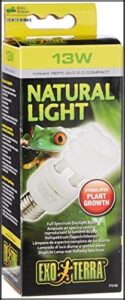
While ball pythons don’t require UVB lighting like many reptiles, the Exo Terra Repti Glo Terrarium Lamp offers optional benefits for your snake’s overall well-being.
This full-spectrum bulb produces minimal heat while delivering UVA radiation that can stimulate natural behaviors and appetite.
With its 6700K color temperature and 98 CRI rating, it enhances your terrarium’s visual appeal without disrupting temperature gradients.
You’ll need to replace the bulb annually since UVB output decreases by 50% over time, maintaining consistent light quality for your python’s environment with a proper replacement schedule.
Best For: Terrarium keepers who want to enhance the natural look and support plant health while providing UVA benefits for reptiles like ball pythons.
- UVB output drops by 50% after one year, requiring regular replacement.
- Not a primary heat source; a separate heating element is still needed.
- Some users find the light output dimmer than previous or alternative bulbs.
- Very high color accuracy (98 CRI) and bright daylight spectrum improves visual appeal.
- Provides UVA to stimulate natural behaviors and appetite in reptiles.
- Minimal heat output so it won’t disrupt your enclosure’s thermal gradient.
3. ReptiChip Coconut Reptile Substrate Bedding
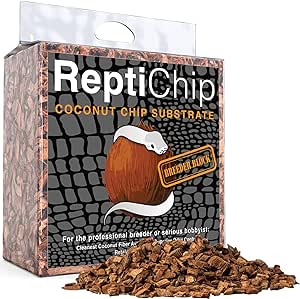
ReptiChip’s premium coconut substrate transforms your ball python’s enclosure into a natural haven.
This triple-washed, organic bedding expands from a compact brick into 72 quarts of fluffy substrate that perfectly mimics forest floor conditions.
You’ll love how it maintains 50-60% humidity levels for weeks, supporting healthy sheds while absorbing odors naturally.
The medium-sized chips encourage burrowing behavior without impaction risks.
Though pricier than alternatives, ReptiChip’s cleanliness and moisture retention make maintenance effortless—just spot-clean waste and mist occasionally to keep your python comfortable.
Best For: ReptiChip is best for reptile owners who want a clean, humidity-retentive, and natural-looking substrate for ball pythons or other humidity-loving reptiles.
- Excellent at retaining moisture and maintaining stable humidity levels for healthy shedding.
- Triple-washed, 100% organic coconut chips minimize dust and odor.
- Encourages natural burrowing and reduces risk of impaction from fine particles.
- More expensive than some local or DIY substrates.
- Can arrive with occasional sharp pieces that require careful inspection.
- Needs regular fluffing and spot cleaning to prevent compaction and maintain freshness.
4. Zoo Med Aspen Snake Bedding
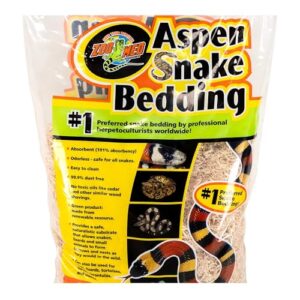
If you want a substrate that makes spot-cleaning simple and supports natural burrowing, Zoo Med Aspen Snake Bedding is a solid pick.
Its soft, dust-free aspen shavings let your ball python dig and nest, just like in the wild.
The high absorbency keeps odors down and waste visible, but it doesn’t hold humidity well, which means you’ll need to monitor moisture and avoid overwatering, or mold can creep in.
Replace the bedding every 2–4 weeks for a clean, healthy enclosure, and be sure to maintain proper conditions to prevent issues, making regular maintenance a key part of using this product.
Best For: Pet owners who want low-dust, easy-to-clean bedding that supports natural burrowing in dry terrarium setups.
- High absorbency helps control odors and keeps the enclosure clean
- Soft, non-toxic aspen shavings support natural digging and nesting behaviors
- Dust-free and hypoallergenic, safe for a wide range of reptiles
- Does not retain humidity well, requiring close monitoring for certain snake species
- Prone to mold if kept damp or not changed regularly
- Lightweight shavings can scatter outside the enclosure during cleaning
5. Galápagos Terrarium Green Sphagnum Moss
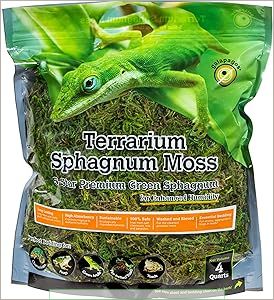
Humidity’s your secret weapon for ball python success, and Galápagos Green Sphagnum Moss delivers perfectly.
This natural moisture magnet maintains ideal 50-60% humidity levels while creating a lush, forest-floor aesthetic.
You’ll love how it holds water without becoming soggy, making shedding effortless for your python.
Place it in humid hides or mix with other substrates for custom moisture zones.
The vibrant green color adds visual appeal while providing natural odor control and mite resistance, and it also helps with humidity levels, making it a great tool for ball python care with its natural moisture.
Best For: Reptile and amphibian owners who want reliable humidity control and a natural look for their terrariums.
- Maintains ideal humidity for healthy shedding and comfort.
- Vibrant, natural green color enhances terrarium aesthetics.
- Naturally resists odors and mites, supporting a cleaner habitat.
- Needs regular cleaning to prevent mold growth.
- Dye may occasionally leach during pre-soaking.
- May require multiple bags for large or densely planted setups.
6. Zoo Med Forest Floor Bedding
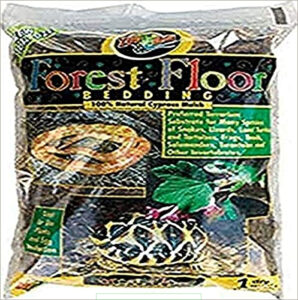
Comfort and reliability make Zoo Med Forest Floor Bedding a favorite among snake keepers.
This 100% natural cypress mulch mimics a forest floor, helping you create a realistic, safe home for your ball python.
It holds moisture well, keeping humidity steady without messy dust or mold, and the texture encourages natural behaviors like burrowing.
Spot cleaning is easy, and many owners mix it with coconut fiber for extra humidity control and a softer feel under your snake’s coils, which can help with humidity control and provide a softer feel.
Best For: Keepers who want a natural, humidity-retaining substrate for ball pythons and other tropical reptiles.
- Maintains steady humidity and is nearly dust-free.
- Encourages natural burrowing and exploration.
- Easy spot cleaning, mixes well for custom setups.
- Pricier than some alternatives, especially for large tanks.
- Occasional large pieces may need removing.
- Full bedding change required every few months.
7. Fluker’s Pothos Repta Vines for Terrariums
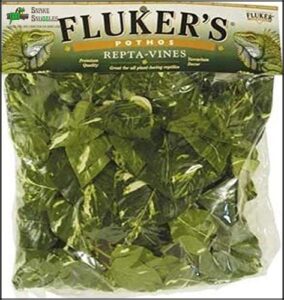
Beyond substrate lies the finishing touch that transforms your ball python’s home from functional to fabulous.
Fluker’s 6-foot Pothos Repta Vines bring natural climbing opportunities and visual appeal to any enclosure. Made from non-toxic polyethylene, these bendable vines withstand repeated cleaning while maintaining their lifelike appearance.
You’ll create vertical space that encourages natural behaviors, though the included suction cups often need upgrading for reliable attachment. Remember to maintain proper humidity levels for your ball python’s health.
Simply shape around existing décor for custom coverage.
Best For: Reptile and amphibian keepers who want easy-to-clean, realistic foliage to enhance tank enrichment and décor.
- Durable, bendable, and easy to shape for custom layouts
- Lifelike appearance provides cover and climbing opportunities
- Simple to clean and doesn’t retain odors
- Suction cups may not hold well and often need replacing
- Some users notice color fading over time
- Metal wire ends can be exposed if trimmed, posing a minor risk
Ball Python Temperature Control
Your ball python’s survival depends on precise temperature control that mimics their West African homeland.
Perfect temperature zones mean the difference between a thriving python and a stressed one.
You’ll need to create distinct thermal zones with a warm side reaching 88-92°F and a cool side maintaining 76-80°F for proper thermoregulation.
Basking Spot Temperature
Dial in your basking spot to an ideal temperature of 90–95°F, giving your ball python a cozy sunbathing area.
Place the basking spot at a safe basking distance, using surface materials that hold heat well.
This thermal gradient supports proper thermoregulation.
Stay sharp with temperature monitoring and temperature control, ensuring the temperature gradient remains steady for your snake’s health.
Cool Side Temperature
Creating the ideal cool side temperature in your ball python habitat requires precision and monitoring.
Your snake needs a temperature gradient that mirrors their natural thermoregulation behavior.
- Ideal Range: Maintain cool side temperatures between 75-80°F, allowing your python to escape excessive heat
- Thermometer Placement: Position digital thermometers at substrate level on the cool side for accurate readings
- Night Drops: Allow temperatures to drop to 70-75°F during nighttime hours, mimicking natural patterns
- Gradient Importance: This temperature difference enables proper digestion and prevents health impacts from overheating
Heat Sources and Thermostats
Pick your heater types wisely—heat lamps, radiant heat panels, or under-tank pads all play a role.
Use thermostats for precise thermostat calibration and steady temperature gradients. It’s important to find the right thermostat products for your setup.
Keep basking surfaces at 88–92°F, while night temperatures can dip to 75–80°F. Always monitor heating with digital thermometers.
Never skip thermostat use; it prevents burns and keeps your snake safe.
Humidity Levels and Monitoring
Your ball python habitat requires precise humidity levels between 50-60% for ideal respiratory health.
During shedding cycles, boost humidity to 70% to prevent shedding issues.
Place your hygrometer in the enclosure’s center and inside humid hides for accurate humidity monitoring.
Choose moisture-retaining substrates like cypress mulch, and establish consistent misting frequency. Infrared heating can help maintain proper temperatures.
Proper humidity control prevents respiratory problems while supporting natural thermoregulation in your ball python habitat.
Ball Python Enclosure Maintenance
You’ll need to keep your ball python’s enclosure clean and well-maintained to support its health and comfort.
Regular cleaning, substrate changes, and careful monitoring of temperature and humidity help prevent illness and keep your snake’s habitat safe and stable.
Cleaning and Disinfecting
Regular cleaning schedules prevent bacterial growth and maintain your python’s health.
Remove waste immediately when spotted, then perform weekly spot cleaning of soiled areas.
Use snake-safe disinfectants like diluted bleach solutions or reptile-specific cleaners.
Monthly deep cleaning involves removing all substrate and decorations, scrubbing surfaces, and allowing complete drying.
To avoid shedding problems, remember to maintain proper humidity levels.
Preventative measures include quarantining new items and maintaining proper humidity to discourage harmful microorganisms, which is crucial for preventing bacterial growth and ensuring the overall well-being of your python.
Substrate Replacement and Maintenance
Proper snake enclosure substrate cleaning starts with spot cleaning waste immediately to prevent odor buildup.
You’ll need consistent substrate maintenance routines to keep your python healthy and comfortable.
Follow these substrate replacement guidelines:
- Spot Cleaning – Remove waste and soiled areas within 24 hours using tongs or scoops
- Full Replacement – Change entire substrate every 4-6 weeks for ideal hygiene
- Substrate Disposal – Bag used bedding properly and disinfect tools after handling
- Mold Prevention – Monitor moisture levels and replace damp substrate immediately to prevent fungal growth
Regular snake enclosure substrate disinfection prevents pest control issues and maintains your pet’s health through proper substrate maintenance practices.
A reptile scooping tool can assist with this task.
Temperature and Humidity Monitoring
After swapping out old substrate, it’s time to keep a sharp eye on temperature and humidity.
Place a digital hygrometer and thermometer in both temperature zones to track your thermal gradient.
Basking temperature should stay steady, and shedding humidity needs a boost.
Good temperature control means checking your gauges daily.
Reliable monitoring helps your ball python stay healthy and stress-free.
Enclosure Upgrades and Modifications
If your thermometer readings look good, think about upgrades that boost your ball python habitat. Small changes can make a big difference.
Here are three ways to level up your snake habitat design:
- Add Automated Systems for lighting or humidity.
- Use Enrichment Items like climbing structures or hides variety.
- Incorporate bioactive setups with natural snake enclosure accessories.
Frequently Asked Questions (FAQs)
What are the habitat requirements for a ball python?
Funny how ball pythons love cozy burrows, right? You’ll need a secure, well-ventilated enclosure, at least 4’x2’x2’, with temperatures from 75–92°F, humidity at 50–60%, and plenty of hiding spots.
What is the best snake setup for a ball python?
You’ll need a 4’x2’x2′ enclosure with secure ventilation, warm side at 88-92°F, cool side at 76-80°F, 50-60% humidity, and appropriate hides for your python’s comfort.
Can you leave a heat lamp on 24/7 for ball python?
You can use heat lamps continuously, but pair them with thermostats to prevent overheating. Ball pythons need consistent warmth, so 24/7 heating maintains proper temperatures for digestion and health.
How often should ball pythons be fed?
Adult ball pythons should eat every 2-3 weeks, while juveniles need feeding weekly. You’ll adjust frequency based on your snake’s age and size for ideal health.
What lighting schedule do ball pythons need?
When darkness falls, pythons thrive!
You don’t need special lighting for ball pythons.
They’re naturally nocturnal, so ambient room light during daytime works perfectly.
No UVB or heat lamps required—just natural day-night cycles.
Can ball pythons live with other snakes?
Ball pythons shouldn’t live with other snakes. Housing them together causes stress, competition for resources, and potential aggression. They’re solitary creatures that thrive alone in properly sized enclosures.
How do I handle my ball python safely?
Support your python’s body properly when lifting, moving slowly and calmly.
Let them feel secure by supporting their weight evenly.
Wash your hands before and after handling to prevent illness transmission, this is crucial for preventing illness transmission.
What signs indicate my ball python is sick?
Watch for appetite loss, difficulty shedding, wheezing or mouth breathing, unusual lethargy, weight loss, mites, stuck shed, or odd discharge. Any behavioral changes deserve attention.
Conclusion
Mastering the perfect snake habitat setup for ball python isn’t rocket science, but one wrong move can turn your scaly friend into a stressed-out mess.
You’ve learned the essential components: proper enclosure size, temperature gradients, humidity control, and substrate selection.
Remember, consistency beats perfection every time, and your ball python thrives on routine and security, so maintain those temperature ranges religiously and monitor humidity levels weekly.
With the right setup, you’ll create a sanctuary where your python feels safe, healthy, and content for years to come.
- https://www.reddit.com/r/ballpython/comments/rxylx1/how_big_should_your_ball_python_tank_be_compared/
- https://inkbird.com/blogs/aquarium-terrarium/ball-python-enclosure-ideas-size-humidity-temperature
- https://www.petmd.com/reptile/ball-python-care-sheet
- https://reptifiles.com/ball-python-care-guide/ball-python-humidity-temperatures/
- https://reptilesupply.com/blogs/how-to-guides/how-to-set-up-a-ball-python-enclosure

